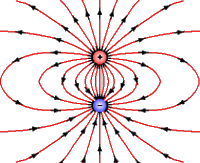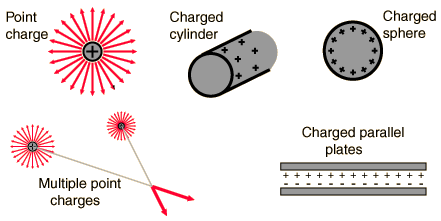Q:
Two charges, q1 and q2, are
situated on a horizontal line. The charge on q1 is (-5q) and
it is at the origin. The charge on q2 is (+2q) and it is a
distance to the right of q1. Find the a point where the
electric field is zero.
Since q1 has a charge of (-5q) and q2 has a
charge of (+2q), does this mean that there is an electric field vector
going from q2 with a magnitude of -3?? To solve this
problem, could I first solve for the electrostatic force using Coulombs
law; set the the resulting equation equal to zero, finally solving for
the distance between the two charges??"
A: The point
in which the total electric field is zero is the point in which a
"positive test charge q-zero" would feel no net force. You
don't need to write equation for forces. You write the
formulas for the two fields created by charge q1 and charge q2,
respectively, and then add these two fields and set the sum equal
zero. As you know the formula for the electric field is E = (the
electric constant ke) multiplied by the charge that creates
the field and divided by the square of the distance from the charge to
the point in which the field is being calculated. So you will have
E1 = (ke) (q1) / (r12) and E2
= (ke) (q2) / (r22). Now substitute
(-5q) for q1 and (+2q) for q2, and now the expressions of the two fields
have different signs: one is positive and one is negative. When
you take the sum of these two terms and make it equal zero, q cancels
out (as being common in both terms), and the resulting equation is an
equation for the distance to the point in which the field is equal
zero. Now solve this equation.
The solution of the problem is: the point with
zero field is at a distance of (2.7 d) from charge q1, or (1.7 d) from
charge q2. Obviously, this point is to the right of both charges,
since a "positive test charge q-zero" placed in this point
would be repelled to the right by charge q2 and attracted to the left by
charge q1. These two attraction forces are equal and opposite, and
the net force is equal zero.
I don't really understand what you mean in your
e-mail when you say that you would like to try "an electric field
vector going from q2 with a magnitude of -3??". I guess you
mean that you would like to add the charges (-5 q) and (+2 q) to a total
charge of (-3 q). Is that what you mean? In this case, that
would be incorrect. Leave the individual charges in the points
where they are located in space. Each of the creates a field
around itself. The two charges cannot be merged (added)
together. The real electric field in each point in space is the
net sum (algebraic sum) of the individual fields created by the
individual charges at the specific point where the net field is
calculated.
It is very important to study
the theory and understand it very well, before attempting to solve
problems. You will realize in this class that the problems are
simple, and most often involve only simple algebraic calculations.
The tricky part (and the most important one) is to
understand in detail the abstract concepts related to fields created by
electric charges positioned in various geometric configurations in
space. Some electrical technologists can apply the laws of
electricity (designing, building, or troubleshooting complex electrical
circuits) without needing to understand the abstract
concepts. For scientists and engineers, though, such
understanding is essential.
For in-depth study of the concept of electric
field, I advise you to also use the "Interactive Java Applet:
Electric Field and Potential Lines" from our "Electric
Fields" and "Electric Potential" tutoring web pages
located at: http://www.slcc.edu/schools/hum_sci/physics/tutor/2220/e_fields/java/index.html. |


